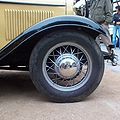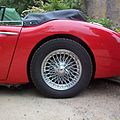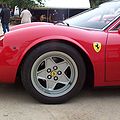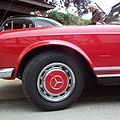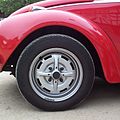Car rim
A car rim is the colloquial term for the wheel of a car without the car tire . In the strict sense refers to the rim only the outer ring formed by the wheel disc or the rim with the wheel flange is connected. Wheels for cars cannot be dismantled non-destructively, rims and wheel discs are welded, riveted or cast in one piece, which results in a synonymy of wheel and rim that is not completely applicable in technical terms (which also applies to tires and wheels). Wheels assembled from several parts are common only for commercial vehicles such as special trucks, tractors (tractors) and some special applications (motorsport).
materials
Car wheels are now made either from rolled steel or cast or forged from light metal . Steel wheels are usually cheaper, but usually less attractive than light alloy wheels. Light alloy wheels can be made lighter than steel wheels, which reduces the unsprung mass and the response of the suspension is better. With modern wheels made of high-strength steels with correspondingly smaller wall thicknesses, the weight advantage shifts in favor of the steel wheel. Cast steel wheels are often still used in commercial vehicles , while motorcycles also have fiber-reinforced composite wheels ( CFRP or plastic reinforced with aramid fibers , commonly known as carbon and Kevlar).
Steel wheel
The most frequently used steel wheel is the disc wheel and usually consists of the rim and the wheel disc or wheel disc. The rims are made of hot-rolled steel with a high yield strength (> 600 MPa ), as are the wheel discs. Both are welded in sections from the inside , since the component would be warped if the weld was continuous. The position of the weld seams is chosen so that they are not exposed to any changing bending stress during dynamic driving loads. This ensures the fatigue strength - vital at this point - which is particularly critical in the case of weld seams.
Light alloy wheel

Light alloy wheels are usually special equipment that is subject to a surcharge. However, they are mainly part of the standard equipment in vehicles from premium car manufacturers, but also increasingly in (special) models from cheaper brands. They are usually made of aluminum - rarely of magnesium - alloys ( Formula 1 , rally made and expensive sports cars) and provided with a special coating. A distinction is made between cast and forged wheels, as well as the aluminum band wheel (disc wheel, structure like steel wheel from rim and wheel disc). A forged aluminum wheel can be significantly lighter than a cast wheel due to the higher strength of the material. The microstructures are not interrupted in the manufacturing process and the material is strain hardened to a high degree due to the deformation. One-piece and multi-piece wheels must be distinguished here. One-piece light alloy wheels consist of a single piece of metal, while multi-piece wheels consist, for example, of a rim base and wheel disc that are screwed or welded together. In the production process, light alloy wheels are usually coated with a matt, silvery coat of paint and a clear coat (usually in a powder coating process) or, more rarely, with a darker finish, possibly in the color of the vehicle. So-called chrome aluminum wheels, which receive a high-gloss surface through electroplating instead of being painted , are popular in the tuning scene .
Light alloy wheels usually do not offer improved performance, greater safety or greater comfort; they serve the appearance of a vehicle. If wheels are particularly light, such as magnesium wheels, the unsprung masses are reduced, which has a positive effect on driving behavior. The cooling of the brakes (greater air permeability compared to a typical steel wheel) is rarely improved, which is why some vehicle manufacturers prescribe light alloy wheels for summer tires , and less often for winter tires . If the brake system requires a rim with a diameter of at least 18 inches, as is the case with some sports cars , only light alloy wheels can be used with winter tires. In older vehicle documents there was a note if only light alloy wheels were allowed to be used, whereby here, too, a distinction was made between summer and winter wheels.
Corrosion resistance is problematic, particularly in the case of inexpensive light alloy wheels . In particular, wintry weather conditions and the associated use of the spreading material de-icing salt , sand or grit can damage the paint layer and thus lead to corrosion. Since the 2000s, however, special "winter aluminum wheels" have increasingly been offered. They are characterized by an increased shock, impact and scratch resistance of the paint compared to standard light alloy wheels and consequently also by improved corrosion resistance.
If the "original" alloy wheels provided by the manufacturer of a motor vehicle for the respective type are not used, the admissibility in road traffic depends on whether they are accompanied by a general operating permit (ABE) or whether they have been entered in the vehicle documents.
Aluminum wheels can be repaired if the degree of damage allows it. Larger damage can only be repaired on two or three-part wheels by replacing the defective part. With these repairs, the screws (usually M7) that connect the rim and wheel disc must also be renewed, as they are designed as expansion screws . The use of old rim bolts is not permitted. One-piece wheels can only be treated superficially (polishing up the surface). In the event of major damage and (deep) cracks, the rim must be replaced. Numerous providers are now dealing with wheel repairs. Modern repair companies often work with X-ray machines to determine damage .
Special forms
A special form of a commercial vehicle rim that is rarely used today is the Trilex rim, also sometimes called the "wheel rim", which is divided into three unequal segments on the circumference. It is attached to the wheel spider with clamping claws (comparable to the wheel disc in a car). When changing tires (or sealing the hose), the wheel spider remains on the vehicle. The rim is dismantled and can be removed from the tire with a simple tool (tire iron) so that the tube can be patched.
photos
Wooden wheels with iron tires on a highwheeler ( Holsman Model 3 1904)
Wooden spoked artillery wheel ; Detail with removable, bolted wheel rim. When changing tires, the spokes remained on the vehicle (Packard Single Six 1923)
1950s: chrome-plated hubcaps (NSU Sport-Prinz)
Wire-spoke wheel with central locking of a roadster from the 1960s ( Austin-Healey )
"Baroque rim", forged wheel made of light metal by Otto Fuchs KG for Mercedes-Benz 1968–1985
Red painted light alloy wheel on the Porsche 996 GT3 RS (2003)
Wheel made of CFRP ( plastic reinforced with carbon fibers ), manufacturer: Arthec Carbonrad GmbH
Modern light alloy wheel with central locking (Porsche 911 built in 2009)
Dimensions
Car hump rims are standardized in DIN 7817 and commercial vehicle (commercial vehicle) rims in DIN 7820.
Decisive for the tires to be used are mainly the diameter and the width of the rim.
- The rim diameter is determined between the rim shoulders. It corresponds to the inner diameter of the tire to be used and is specified as an inch code.
- The rim width is measured between the rim flanges (the inner distance) and is also known as the mouth width.
Whether a wheel can be mounted on a vehicle from a technical point of view depends on the number of holes and the bolt circle of the hole rim , the diameter of the wheel hub bore and the offset :
- The number of holes with which the wheel is screwed is at least three, but usually four or five; more for off-road vehicles or trucks (exception: central locking with wing nut as with the roadster in the picture above).
- The bolt hole circle (LK) denotes the diameter in mm of the circle on which the center points of the screw holes lie.
- The center hole is the center hole with which the wheel is attached to the wheel flange.
- The offset (ET) indicates the deviation between the center of the wheel and the inner contact surface of the wheel disc on the wheel hub (referred to as a mirror ), i.e. the brake drum or brake disc . It is given in mm. If the offset is 0 mm, the wheel rests on the brake drum in the plane of symmetry of the tire. If it is greater than 0, i.e. a positive ET, the wheel extends further inwards, i.e. the track width (measured from tire center to tire center) becomes smaller. If the ET is negative, the track width is increased and the wheel moves further outwards.
Instead of the abbreviation ET, some manufacturers (e.g. Ford) also use the English abbreviation OS (= offset).
- The diameter of the holes on the bolt circle is also decisive, for example Mercedes-Benz and Volkswagen use wheels with identical dimensions for their vans, but the mounting screws in one case have a 12 mm thread and in the other a 14 mm thread.
Example of a car wheel designation:
-
7½J × 16 H2 ET15, LK 5 × 110 MZ57
- 7½ = mouth width code (rim width), corresponds to the mouth width in inches (from the inside of the rim flange to the rim flange)
- J = Designation for the rim flange version (here: Form J, corresponds to a height of 17.3 mm), other versions: H, P, K, JK etc.
- × = Designation of a one-piece drop center rim (× is now spoken as “mal”, originally the language “X” was intended), other version: - (pronounced “dash”) denotes a multi-part flat center rim
- 16 = rim diameter code, corresponds roughly to the rim diameter in inches (measured on the rim shoulder)
- H2 = hump in this case on both sides (2) (prevents the tire from slipping into the low bed when cornering)
- ET 15 = offset positive (+) 15 mm (with negative ET the minus sign is in front of it, for example ET −15)
- LK = bolt circle of the wheel
- 5 × = number of bolt holes
- 110 = diameter of the bolt circle in mm that runs through the center of the mounting holes
- MZ = hub bore or center hole centering (MZ), here as an example 57 mm diameter
Vehicles have different hub bores. Light alloy wheels in the tuning area usually have larger bores. With the help of a centering ring (made of plastic), the difference in diameter between the wheel and the vehicle is adjusted. Steel wheels are only available with the same bore diameter as the vehicle.
The specification describes a wheel with a one-piece drop center rim with a double hump, 7.5 "internal width, 16" diameter, a rim flange in J design, a positive offset of 15 mm and 5 mounting holes distributed on a circle with a diameter of 110 mm. The hump version suggests the usability of tubeless tires, but is not mandatory.
Assembly of car wheels
Car wheels are dismantled by loosening the wheel nuts or bolts, then lifting the vehicle and loosening the wheel nuts or bolts completely. The wheel can then be removed from the hub and the new wheel can be mounted in the reverse order of the work steps: After fitting new tires, the wheels are balanced before mounting on the vehicle . A so-called centering bolt can be used to put the wheel back onto the wheel hub exactly for screwing. When installing, after inserting the wheel bolts and before lowering the vehicle, the screw connection is usually tightened with an impact wrench or torque wrench, whereby the respective tightening torque of the manufacturer must be observed. If the mounted wheels are not original parts from the vehicle manufacturer, they either require a general operating permit (ABE) from the Federal Motor Transport Authority , the number of which is specified on the wheel as a KBA number, or they must be entered in the vehicle documents by an officially recognized expert. The use of wheels without ABE or registration leads to the expiry of the vehicle's operating license and is illegal .
Speedometer display
A speedometer measures the speed of the car wheels and uses it to calculate the (theoretical) speed of the car ( slip neglected). If the rim is changed to a different diameter , but also with every other tire size change, make sure that the rolling circumference of the wheel remains the same. This can be achieved by choosing a different tire cross-section. This adjustment can only insufficient, the speed displayed is no longer correct, as indicated by a speedometer adjustment needs to be fixed.






